Battle
On 3 January 1781, a frigate division departed Brest to cruise at the entrance of the English Channel. It comprised the 32-gun frigates Fine, under Tanouarn, and Minerve, under Grimouard, as well as the lighter 26-gun Diligente and Aigrette.
In the morning of 4, in heavy weather, the division detected the British 74-gun HMS Valiant and Courageux, under Mulgrave, and the frigate tried to escape. At 1330, Courageux caught up with Minerve and engaged. Grimouard was wounded in the battle, and Lieutenant Villeneuve took over. One hour later, Valiant also engaged Minerve, which then struck her colours. After Minerve surrendered, Valiant chased Fine, which successfully escaped.
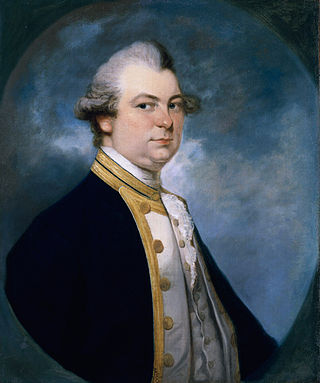
Constantine John Phipps, 2nd Baron Mulgrave was an English explorer and officer in the Royal Navy. He served during the Seven Years' War and the American War of Independence, seeing action in a number of battles and engagements. Inheriting a title, he also went on to have a successful career in Parliament and occupied a number of political offices during his later years.

Jean-Baptiste Perrée was a French Navy officer and Rear-admiral.
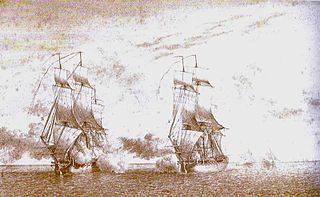
Belle Poule was a French frigate of the Dédaigneuse class, designed by Léon-Michel Guignace. She is most famous for her duel with the British frigate HMS Arethusa on 17 June 1778, which began the French involvement in the American War of Independence.
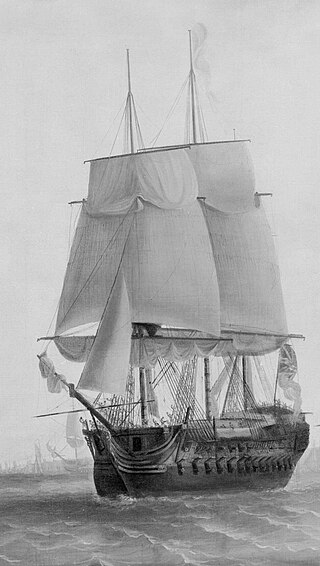
Courageux was a 74-gun ship of the line of the French Navy, launched in 1753. She was captured by the Royal Navy in 1761 and taken into service as HMS Courageux. In 1778 she joined the Channel Fleet, and she was later part of the squadron commanded by Commodore Charles Fielding that controversially captured a Dutch convoy on 31 December 1779, in what became known as the Affair of Fielding and Bylandt. On 4 January 1781, Courageux recaptured Minerva in a close-range action west of Ushant that lasted more than an hour. That April, Courageux joined the convoy under George Darby which successfully relieved the Great Siege of Gibraltar.

Jean-Marthe-Adrien L'Hermite was a French sea captain and rear admiral, notable for his involvement in the Glorious First of June and his expedition into the Atlantic in 1805.

Minerve was a 40-gun Minerve-class frigate of the French Navy. The British captured her twice and the French recaptured her once. She therefore served under four names before being broken up in 1814:

Surveillante was an Iphigénie-class 32-gun frigate of the French Navy. She took part in the Naval operations in the American Revolutionary War, where she became famous for her battle with HMS Quebec; in 1783, she brought the news that the war was over to America. She later took part in the French Revolutionary Wars, and was eventually scuttled during the Expédition d'Irlande after sustaining severe damage in a storm. The wreck was found in 1979 and is now a memorial.

Hermione was a 32-gun Concorde-class frigate of the French Navy. Designed for speed, she was one of the first ships of the French Navy to receive a copper sheathing. At the beginning of the Anglo-French War of 1778, she patrolled in the Bay of Biscay, escorting convoys and chasing privateers. She became famous when she ferried General La Fayette to the United States in 1780 in support of the rebels in the American Revolutionary War. She took an incidental role in the Battle of Cape Henry on 16 March 1781, and a major one in the action of 21 July 1781.

Pierre-François-Henri-Étienne Bouvet de Maisonneuve was a French Navy officer and privateer.
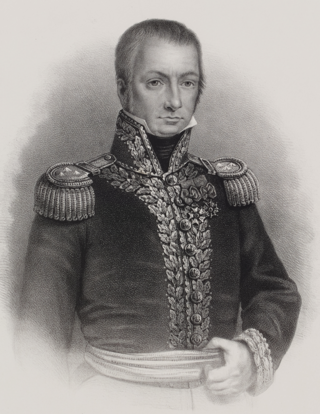
Amable Gilles Troude was a French Navy officer, who served in the Napoleonic Wars.

Nicolas Henri René de Grimouard was an officer in the French Navy. He served in the War of American Independence, and became a member of the Society of the Cincinnati.
Samuel Granston Goodall was an officer of the Royal Navy who saw service during the Seven Years' War, the American War of Independence and the French Revolutionary Wars in a career that spanned 50 years, rising to the rank of Admiral of the White.
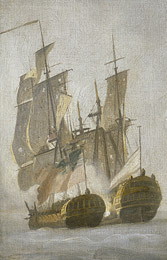
HMS Minerva was one of the four 32-gun Southampton-class fifth-rate frigates of the Royal Navy. She was launched in 1759 and served through the Seven Years' War, but was captured in 1778 during the American Revolutionary War and served as the French Minerve until being recaptured in 1781 and renamed HMS Recovery. She was broken up in 1784.

The action of 10 April 1795 was a minor naval engagement during the French Revolutionary Wars in which a squadron of French Navy frigates was intercepted by a British battle squadron under Rear-Admiral John Colpoys which formed part of the blockade of the French naval base of Brest in Brittany. The French squadron split up in the face of superior British numbers, the three vessels seeking to divide and outrun the British pursuit. One frigate, Gloire was followed by the British frigate HMS Astraea and was ultimately brought to battle in a closely fought engagement. Although the ships were roughly equal in size, the British ship was easily able to defeat the French in an engagement lasting just under an hour.
Allemand's escape from Lorient was an episode of the naval operations of the French Navy in 1812. A number of French, warships trapped in Lorient by the British blockade, managed to take to the sea under Zacharie Allemand and sail to Brest. British squadrons sailed in pursuit, but were unable to force the French fleet into action.
Créole was a 40-gun frigate of the French Navy, a one-off design by Jacques-Augustin Lamothe. The French Navy loaned her to a privateer in 1797. Later, she served in the Brest squadron, took part in Ganteaume's expeditions of 1801 to Egypt, and was involved in the French acquisition of Santo Domingo and briefly detained Toussaint Louverture before he was brought to France. The 74-gun ships HMS Vanguard and HMS Cumberland captured her Santo Domingo on 30 June 1803. The Royal Navy took her into service but she foundered soon afterwards during an attempt to sail to Britain; her crew were rescued.
Louis Augustin de Monteclerc was a French Navy officer. He served in the War of American Independence.
Jean de Brun de Boades was a French Navy officer. He served in the War of American Independence.
Jean-Marie de Villeneuve Cillart was a French Navy officer. He served in the War of American Independence.
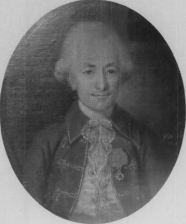
Georges-François Godefroy Framond de La Framondie was a French Navy officer. He served in the War of American Independence, earning membership in the Society of the Cincinnati.
This page is based on this
Wikipedia article Text is available under the
CC BY-SA 4.0 license; additional terms may apply.
Images, videos and audio are available under their respective licenses.













